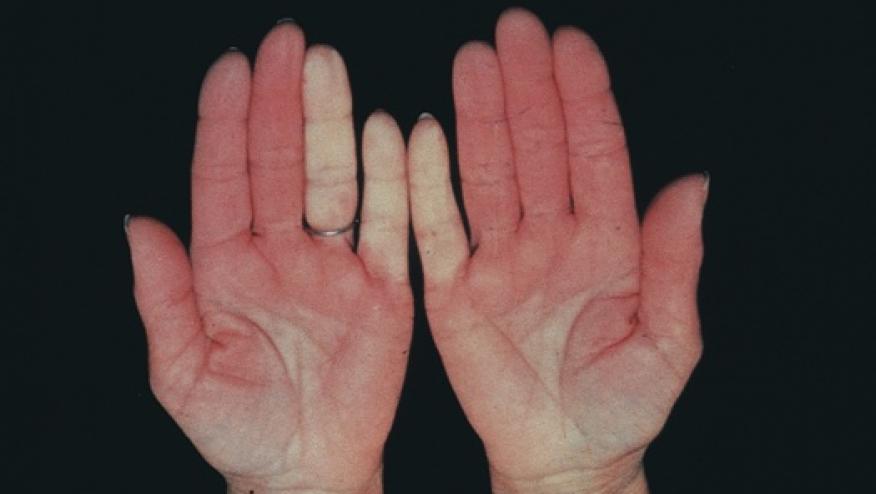Scleroderma Raynaud's May Worsen in Summer Save

Episodes of Raynaud's phenomenon, a common feature of systemic sclerosis (SSc, also known as scleroderma), were more severe not only at low temperatures, as one would expect, but also during summertime heat, a multinational study found.
In a statistical model based on data from 2,243 SSc patients enrolled in the Scleroderma Patient-centered Intervention Network (SPIN) Cohort, the worst episodes occurred after outdoor temperatures had fallen to -25°C (-13°F), with Raynaud severity ratings of 6.8 out of 10, according to Brett D. Thombs, PhD, of the Lady Davis Institute for Medical Research at Jewish General Hospital in Montreal, and colleagues.
But Raynaud severity was nearly as bad, at 5.6 points, when temperatures reached 40°C (104°F), the group reported in Lancet Rheumatology.
Under more comfortable conditions, Raynaud's phenomenon was markedly less severe, with a rating of 2.6 points in the model when temperatures were at 25°C (77°F). The pattern was similar, though severity ratings at the extremes were somewhat attenuated, when the researchers used "feels like" temperatures, in which thermometer readings are adjusted for wind chill in winter and humidity in summer.
Raynaud's phenomenon (seen in up to 95% of SSc patients) occurs when the sympathetic nervous system causes vasospasm that cuts blood flow to the extremities; the fingers and toes may turn blue and lose feeling, or become painful. It has always been considered a response to cold temperatures, so the worsened episodes during hot weather were something of a surprise. Thombs and colleagues speculated that air conditioning was responsible for this observation.
Authors of an accompanying editorial, however, suggested that high temperatures themselves could induce Raynaud's attacks.
"Some patients with advanced systemic sclerosis might experience a relative hypovolemic state due to increased sweating and hypotension," wrote Maurizio Cutolo, MD, of the University of Genoa in Italy, and two colleagues. "This reduced blood volume and peripheral blood flow could potentially induce Raynaud's-like symptoms by decreasing blood supply to the extremities."
Cutolo and colleagues also noted that the study didn't take account of participants' use of vasodilators, which could easily affect their susceptibility to Raynaud's and the severity of episodes.
Nevertheless, both the editorialists and the study authors agreed that the findings are relevant to managing SSc patients suffering from Raynaud's phenomenon.
"Among the key messages for clinicians, the importance of advising patients with secondary Raynaud's phenomenon to avoid not only cold outdoor environments, but also to be cautious with air conditioned spaces in warm climates, should be emphasized," Cutolo and colleagues wrote.
For their part, Thombs and colleagues said the study results "will be useful for clinicians and patients to identify periods of heightened risk for Raynaud's attacks that might occur despite steps taken to reduce exposures." They noted that it's probably not practical to advise patients to avoid air conditioning during hot weather, since it's now virtually ubiquitous (and often excessive) in public buildings and workplaces.
The investigators undertook the study because, until now, the only studies to examine Raynaud's in SSc patients as a function of temperature were small and lacked key data.
SPIN includes patients under treatment at 44 clinics in the U.S., Canada, Mexico, France, Spain, Great Britain, and Australia, with visits recorded from 2014 to 2023. Out of 2,668 total SPIN participants, the 2,243 included in the current analysis were those who had at least one severity evaluation for a Raynaud's attack and weather data available for the week preceding the evaluations. In actuality, more than 20,000 such evaluations were performed on participants.
Some 85% of participants were from the U.S., Canada, and France. About 88% of participants were women and mean age was 55.
Although the data showed Raynaud severity increased at both ends of the temperature spectrum relative to the middle, the model didn't produce a simple U-shaped curve. In cold weather, attack severity remained high (≥4.45) even as temperatures rose to 5°C (23°F). As weather warmed from there, however, attack severity dropped more rapidly: in the range of 10-25°C, each 5-degree increment came with reductions in severity of 0.37-0.54 points. Temperature increases beyond 25°C then came with marked severity increases, including a whopping 2.11-point jump for the increase from 35°C (95°F) to 40°C.
In their editorial, Cutolo and colleagues indicated that the findings warrant further exploration. "Longitudinal studies examining secondary Raynaud's phenomenon severity, considering the interplay between environmental factors and Raynaud's phenomenon outcomes, would be beneficial," they wrote, adding that effects of climate change could become observable in the near future. (They cited one study suggesting that global warming will reduce attack frequency, but the current findings put that in some doubt.)
Another topic the editorialists suggested to examine is sex differences in Raynaud's and the role of estrogen, which is active in pathways that can either decrease or increase susceptibility to the phenomenon.
Source Reference: Virgili-Gervais G, et al "The association of outdoor temperature and self-reported Raynaud's phenomenon severity among people with systemic sclerosis: A Scleroderma Patient-centered Intervention Network Cohort study" Lancet Rheumatol 2024; DOI: 10.1016/S2665-9913(24)00189-9.









If you are a health practitioner, you may Login/Register to comment.
Due to the nature of these comment forums, only health practitioners are allowed to comment at this time.